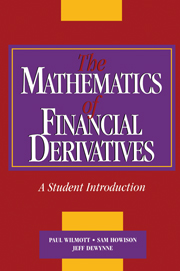10 - Binomial Methods
from Part Two - Numerical Methods
Published online by Cambridge University Press: 05 June 2012
Summary
Introduction
Binomial methods for valuing options and other derivative securities arise from discrete random walk models of the underlying security. They rely only indirectly on the Black-Scholes analysis through the assumption of risk neutrality; their relation to the partial differential equation and inequality models described and derived earlier in this book becomes evident only when it is seen that binomial methods are particular cases of the explicit finite-difference method described in Chapter 8 (see Exercise 5).
There are two main ideas underlying the binomial methods. The first of these is that the continuous random walk (2.1) may be modelled by a discrete random walk with the following properties:
The asset price S changes only at the discrete times δt, 2δt, 3δt, …, up to Mδt = T, the expiry date of the derivative security. We use δt instead of dt to denote the small but non-infinitesimal time-step between movements in the asset price.
If the asset price is Sm at time mδt then at time (m + 1) δt it may take one of only two possible values, u Sm > Sm or ∂ Sm < Sm. (That is, during a single time-step, the asset price may move from S up to uS or down to ∂ S; see Figure 10.1). Note that this is equivalent to assuming that there are only two returns δS/S possible at each timestep, u - 1 > 0 and ∂ - 1 < 0, and that these two returns are the same for all time-steps.
[…]
- Type
- Chapter
- Information
- The Mathematics of Financial DerivativesA Student Introduction, pp. 180 - 194Publisher: Cambridge University PressPrint publication year: 1995
- 1
- Cited by



